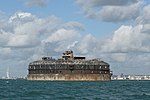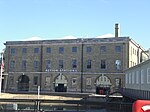HMS Invincible (1747)
1744 in France1744 ships1758 in EnglandCaptured shipsMaritime incidents in 1758 ... and 4 more
Protected Wrecks of EnglandShips of the line of the French NavyShips of the line of the Royal NavyShipwrecks in the Solent

Invincible was originally a 74-gun ship of the line of the French Navy launched in October 1744. Captured on 14 May 1747, she was taken into Royal Navy service as the third rate HMS Invincible. She was wrecked in 1758 after hitting a sandbank. The wreck is a Protected Wreck managed by Historic England.
Excerpt from the Wikipedia article HMS Invincible (1747) (License: CC BY-SA 3.0, Authors, Images).HMS Invincible (1747)
Geographical coordinates (GPS) Address Nearby Places Show on map
Geographical coordinates (GPS)
| Latitude | Longitude |
|---|---|
| N 50.742777777778 ° | E -1.0397222222222 ° |
Address
Mengham
PO11 9BG
England, United Kingdom
Open on Google Maps








